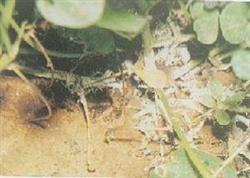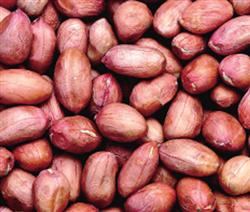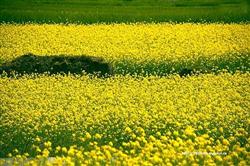Comprehensive control measures of white silk disease of peanut

Peanut white silk disease is a kind of soil-borne fungal disease, which occurs at the stage of peanut pod expansion to maturity. After the damage to the root, pod and stem base of peanut, there was brown soft rot at the beginning, white silk mycelium in the aboveground rhizome (so called white silk disease), and rape seed sclerotia, stems and leaves turned yellow, gradually withered, peanut pods rotted. The effect of prevention and treatment of the disease is poor. Peanut white silk pathogen spreads with soil, running water and seeds, which is very dangerous. Once invaded, the pathogen accumulates year after year, and it is difficult to control and eradicate it later. Under suitable conditions, the hyphae produced by sclerotia germination invade directly from the root or stem base of peanut or from the wound, propagate and cause rhizome disease and rot. Mature sclerotia on new diseased plants can be transmitted by Rain Water, irrigation water, insects, agricultural operations and other factors, causing re-infection. In the whole growing season of peanut, the pathogen can be infected repeatedly for many times, and finally the sclerotia formed by the diseased tissue falls into the soil or remains in the diseased plant to overwinter. Prevention and control measures: 1. Clean pastoral peanuts after harvest will be timely and thoroughly clear the field, leaving no stubble, in order to eliminate the source of overwintering bacteria. two。 Reasonable rotation can be carried out with Gramineae crops for more than 3 years to reduce the accumulation of bacteria. 3. Soil disinfection combined with spring ploughing, deep ploughing, 2 kg / mu with 70% thiophanate methyl, mixed well with fine soil and sprinkled in the soil to eliminate residual bacteria. 4. Strengthen field management to make scientific and rational use of nitrogen, phosphorus and potassium fertilizer, and increase the application of organic fertilizer, zinc fertilizer, calcium fertilizer and boron fertilizer. Check and replenish peanut seedlings in time after emergence to ensure that the whole seedling, moderate density; weeding and famine prevention in the middle growth stage, in order to facilitate ventilation and light transmission, enhance plant disease resistance and control the occurrence of white silk disease. 5. In order to reduce the accumulation and spread of pathogens and control the epidemic speed and degree, the diseased plants were pulled out in time during the growing season of peanuts. 6. Drug control can use 50% isobarbazide, 50% carbendazim 1000 times solution, 40% sclerotia net 600 times solution, 50% carbendazim 800 times solution, or tebuconazole, difenoconazole and other road agents alternately sprayed 2 times 3 times, once every 7 to 15 days, pay attention to spray foot evenly. The root can also be irrigated with 800 times solution of 70% thiophanate during the podding period of peanuts, and the control effect is very obvious.
- Prev

There is no pest when peanuts are mixed with seeds-chlorpyrifos
Peanut mixed with seed is pest-free-chlorpyrifos peanut mixed with non-pest is a kind of non-toxic, non-residual biological insecticide, which mainly acts on the nervous system of underground pests, causing metabolic disorder, hunger strike and death, especially sensitive to larvae. Seed dressing at one time can play a role in the soil for more than 130 days.
- Next

Re-application of Boron in rape with High quality, High yield and stable yield
Rapeseed (Brassica napus L.) is a boron-demanding crop, especially high-yield and high-quality Brassica napus "double-low" hybrid rape is particularly sensitive to boron deficiency, slow rooting at seedling stage, dark green, wrinkled leaves and hindered growth; boron deficiency at bud stage, rhizome expansion, leaf color turning purple to blue-purple, abnormal flower bud development; boron deficiency at flowering stage, plant dwarfing, pollen.
Related
- The first cup of black tea in spring, the flavor and history of tea gardens in Kenya, Africa
- The computer can not only choose potatoes, but also grow tea rice. AI will grow winter oolong tea champion.
- It is not only the inflated tea bitten by insects, but also engraved with the four seasons tea in Beipu.
- The Oriental Beauty Tea Festival in Zhuxian County takes the stage at the weekend to experience the plus-size feast of oil tea.
- & quot; Oriental Beauty Tea & Exploration of Emei in Hsinchu, the hometown of quot;
- The new variety of strawberry "Tainong 1" dessert is the first choice with mellow aroma. Crimson gorgeous
- History of Tea in Taiwan: from Wild Inner Mountain to Export Tea Garden
- Two types of Taiwan Oriental Beauty Black Tea won the British three-Star Award for Childhood Tea Xiang Zhang Jiaqi changed from pilot to champion tea maker.
- Banana species and varieties: the planting history of Taiwan Xianren banana and dwarf banana is long, is banana disease resistant?
- Coffee planting Technology: Qianjie Coffee from Seedling to harvesting

